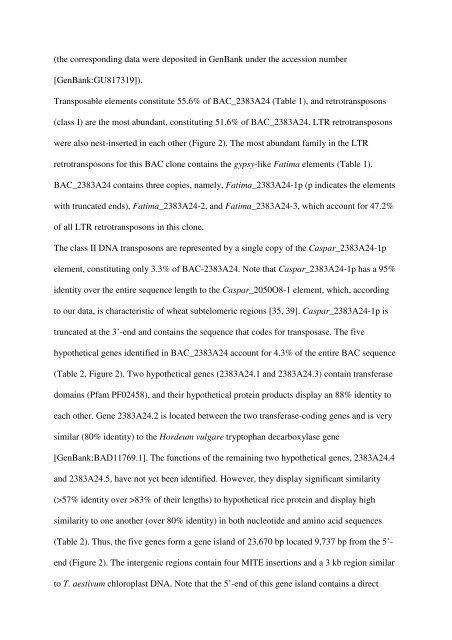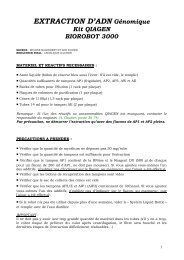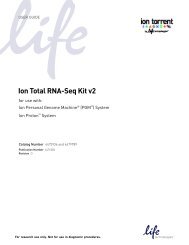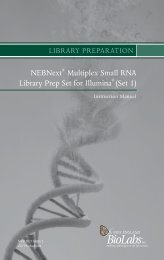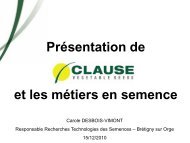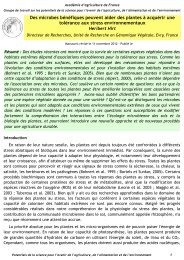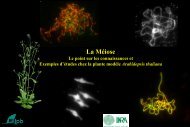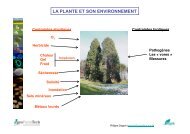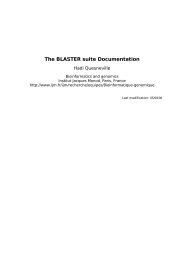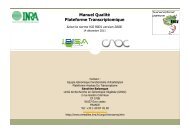The impact of Ty3-gypsy group LTR retrotransposons ... - URGV - Inra
The impact of Ty3-gypsy group LTR retrotransposons ... - URGV - Inra
The impact of Ty3-gypsy group LTR retrotransposons ... - URGV - Inra
Create successful ePaper yourself
Turn your PDF publications into a flip-book with our unique Google optimized e-Paper software.
(the corresponding data were deposited in GenBank under the accession number<br />
[GenBank:GU817319]).<br />
Transposable elements constitute 55.6% <strong>of</strong> BAC_2383A24 (Table 1), and <strong>retrotransposons</strong><br />
(class I) are the most abundant, constituting 51.6% <strong>of</strong> BAC_2383A24. <strong>LTR</strong> <strong>retrotransposons</strong><br />
were also nest-inserted in each other (Figure 2). <strong>The</strong> most abundant family in the <strong>LTR</strong><br />
<strong>retrotransposons</strong> for this BAC clone contains the <strong>gypsy</strong>-like Fatima elements (Table 1).<br />
BAC_2383A24 contains three copies, namely, Fatima_2383A24-1p (p indicates the elements<br />
with truncated ends), Fatima_2383A24-2, and Fatima_2383A24-3, which account for 47.2%<br />
<strong>of</strong> all <strong>LTR</strong> <strong>retrotransposons</strong> in this clone.<br />
<strong>The</strong> class II DNA transposons are represented by a single copy <strong>of</strong> the Caspar_2383A24-1p<br />
element, constituting only 3.3% <strong>of</strong> BAC-2383A24. Note that Caspar_2383A24-1p has a 95%<br />
identity over the entire sequence length to the Caspar_2050O8-1 element, which, according<br />
to our data, is characteristic <strong>of</strong> wheat subtelomeric regions [35, 39]. Caspar_2383A24-1p is<br />
truncated at the 3’-end and contains the sequence that codes for transposase. <strong>The</strong> five<br />
hypothetical genes identified in BAC_2383A24 account for 4.3% <strong>of</strong> the entire BAC sequence<br />
(Table 2, Figure 2). Two hypothetical genes (2383A24.1 and 2383A24.3) contain transferase<br />
domains (Pfam PF02458), and their hypothetical protein products display an 88% identity to<br />
each other. Gene 2383A24.2 is located between the two transferase-coding genes and is very<br />
similar (80% identity) to the Hordeum vulgare tryptophan decarboxylase gene<br />
[GenBank:BAD11769.1]. <strong>The</strong> functions <strong>of</strong> the remaining two hypothetical genes, 2383A24.4<br />
and 2383A24.5, have not yet been identified. However, they display significant similarity<br />
(>57% identity over >83% <strong>of</strong> their lengths) to hypothetical rice protein and display high<br />
similarity to one another (over 80% identity) in both nucleotide and amino acid sequences<br />
(Table 2). Thus, the five genes form a gene island <strong>of</strong> 23,670 bp located 9,737 bp from the 5’-<br />
end (Figure 2). <strong>The</strong> intergenic regions contain four MITE insertions and a 3 kb region similar<br />
to T. aestivum chloroplast DNA. Note that the 5’-end <strong>of</strong> this gene island contains a direct


